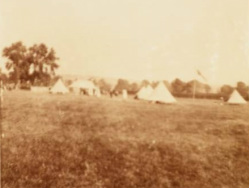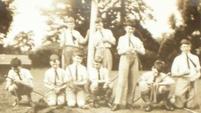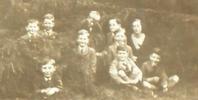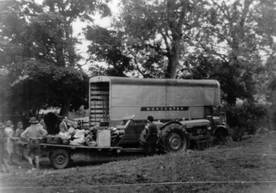Scouting and Camp
Scouting at Aymestrey School was an important part of school life. It began in Malvern, where the boys were members of the 4th Malvern Link Scout Troup, and the annual summer camp started there, but at some point, perhaps with the move to Crown East, this activity ceased for a while. |
|
Scouting started at Crown East in the summer of 1932 |
The highlight of the scout year was the Summer Camp. It also appears to have been one of the highlights of Dan’s year, as his camps are described in great detail in the School magazines. For a description of early 1960’s camps see Memories or 1961 Camp. See also the CampTimeline; Scout Camp Standing Orders and Scout Tests.
In the early years it was a long weekend at the start of the summer holiday, but in 1943 it was extended to a week, the second half of which was from the holidays. Most of these camps took place in or around the Aymestrey grounds, often in the Scout or Lower Wood near the swimming pool. See Early 1940s Camps.
From 1947 the troop went to Wales. At this time it was on land owned by Admiral Phillips at Llanfechan. See Camp at Llanfechan.
|
In 1954 a new site at Cefn Llys was used – with a couple of exceptions Cefn Llys, either above or below Stony Dingle Pool, was used until 1977, which was also DANA’s last camp.
|
|
At first they traveled by train for these away camps, but in 1951 Ernest Batty’s furniture van was used for both the gear and the boys. This continued until 1973 when regulations made this impossible. Thereafter a convoy of smaller vehicles was used, driven by staff, parents, old boys or other helpers |
|
_
(We) were required to look after (our)selves (and the Scoutmaster)
to a high standard. Not for us adult cooks or gas stoves or toilet blocks. To
be allowed to camp we had to be proficient in a whole range of skills –
cooking, knots, first aid, map reading, woodcraft and axemanship, digging, fire
lighting and of course general camping and tent skills. We cut all our own
wood, cooked on open fires, and not just baked beans, but joints of lamb with
fresh peas and potatoes with ‘wild mint’ sauce. Washing up was done in the
river using moss and sand – no detergent and all grease into the grease pit. We
were skilled at keeping ourselves dry and healthy. Dan always considered that
it had been a poor camp unless it had rained hard at some point. He led us on
two long expeditions – one of which always ended up at the Severn Arms Hotel in
Penybont where a huge tea was laid on. When we left and struck camp at the end
of the week it was essential that we left no sign that we had been here. No litter or damage. All turf replaced where the fires had burnt and any
structures such as dams or bridges removed. We were taught, by example, to
respect the environment.
John Chandler (1956-1961) |
|
In 1975 ‘Scouting’ became ‘Outdoor Club’ because DANA had reached the compulsory age limit for Scout Leaders. |
‘We are trying to keep as much as possible that was of value … and dropping what did not suit us … more emphasis on really practical outdoor knowledge, and … an interest in wild life. Boys learn … what clothes are best for all-weather use, … how to look after their boots and feet, safety-rules for hill-walking, the characteristics of different firewoods, the recognition of the more common birds and trees …’
|
From 1978 camps were led by Marcus Cash, and were for the Fifth Form only; in the same year the first trip to the Outdoor Adventure Centre of Ru’a Fiola in Scotland happened. See 1982 Camp.
_In 1979 the GreenPrice (OA) farm was used, and this continued until
1992. After that various different arrangements were made. See Timeline.




